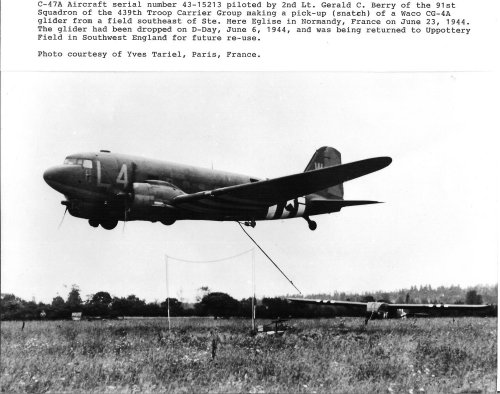Rescue at Remagen

Wounded are carefully loaded into the glider by Army medical personnel. Photo courtesy of Howard Cloud.
When the glider was completely loaded the front section was secured in place and the glider fastened to the pick-up station as Major Cloud assumed his position at the controls. Joining him in the co-pilot seat for the historic return trip was a chief surgeon of the 1st Army, Col. Ansbacker. The pick-up station consisted of two red and white striped poles set twenty feet apart. The pick-up loop was suspended between the poles twelve feet in the air. Bud Berry writes, "A standard procedure for pick-up when there were to be no radio communications was to place a broad yellow banner, on the pick-up run in and near the pick-up station, and perpendicular to the path of flight. When the glider was ready for pick-up the yellow banner was changed to a position leading right into the pick-up station parallel to the line of flight. That was the procedure followed that day." Tension began to build in the gathered crowd of GI’s and one watching soldier remarked to another, "I bet those boys inside are mighty nervous in the service right now." Testing the glider controls Cloud yelled out for somebody to check his rudder and a GI ran back and then forward to the cockpit an informed Cloud that all was okay.
{default}Meanwhile, circling overhead Berry and his crew awaited the signal to attempt the pick-up. Having no idea of the weight to expect he and his crew chief discussed the setting of the brake in the pick-up unit, concerned over what a severe jolt would do to the wounded inside the glider. After considering all the angles he instructed the crew chief to set the unit as loosely as possible and stand-by the brake to apply more as required. Once the signal was given Berry dropped the C-47 into lower and lower circles then turned north away from the field to set up the pick-up approach. Berry described his approach this way, "After releasing the glider we flew a regular traffic pattern to the right at constant altitude. To the south out over the bridge, 90 degree turn to the right, 90 degree turn to the right onto the downwind leg, 90 degree turn onto the base leg and a 90 degree turn onto final approach and back over the glider. This was repeated over and over until the glider was ready for pick-up. A yellow panel was placed in front of the pick-up station and perpendicular to the line of flight until the glider was ready, at that time the panel was rotated to parallel to the flight line on the approach. As we flew the pattern we observed the panel each time we crossed the station and when it was rotated we made the snatch on the next pass."
With a final turn, in what must have been an impressive sight to those on the ground, he came in very fast and low. The roar of the C-47 so close to the ground was deafening and as the plane passed over Cloud’s glider filled with wounded, the trailing hook hit the pick-up station on target, the rope went taut, the glider pitched once, and it was airborne.

Photo Courtesy of Gerald "Bud" Berry.
As the amazed soldiers watched the C-47 and glider join the awaiting fighter escort Lt. Steve Campbell remarked, "I feel like I’ve just watched the Wright brothers take off at Kitty Hawk." Aboard Berry’s C-47 the crew had sweated out the pick-up. To Berry the pay out of the cable seemed faster than normal and the reassuring feeling of the gentle tug of the glider in tow seemed to take longer than usual. When the expected whine of the unit stopped crew chief Al Furr appeared and announced to the pilots that there was but one rotation of cable left on the drum. Berry wrote later in a letter to Col. Charles H. Young, the CO of the 439th that, "We had given those glider passengers the easiest, smoothest ride they could have gotten. Only the crew knew how close we had come to losing them completely."
In less than thirty minutes Cloud and the precious cargo of wounded was over the field hospital. When Major Cloud asked Col. Ansbacker where he wanted the glider the surgeon pointed to a large surgical tent with a Red Cross insignia on the roof. After he cut loose, Cloud expertly maneuvered the glider into position for landing. When the wheels touched down the glider rolled right up to the entrance and stopped. Watching from above Bud Berry later wrote that Cloud was, "so close that when the nose was lifted it completely covered the entrance canopy. If it had been raining, those patients wouldn’t even have gotten wet."
On the heels of the first glider snatch of wounded in the ETO a second snatch was done that day by a crew from the 441st TCG, the snatch was executed by pilot, 1st Lt. John F. Clippard.


Dear Sir,
I read Your report with great interest. But could You give me an idea where the airfield? near remagen was exactly located?
Yours faithfully
Heribert Selzer
Auf Jägert 7
53572 Unkel (Rhein)